Welcome to our guide on swimming pool test kit instructions. Learn how to use a pool test kit for clean, safe, and balanced water conditions.
Importance of Regular Pool Water Testing
Regular pool water testing is essential for maintaining clean, safe, and enjoyable swimming conditions. It ensures proper chemical balance, preventing eye irritation, skin discomfort, and respiratory issues for swimmers. Testing helps detect imbalances in pH, chlorine, alkalinity, and stabilizer levels, which can damage pool equipment or lead to algae growth if left unchecked. By monitoring water chemistry, you can make informed adjustments to maintain optimal conditions. Consistent testing also prevents costly repairs and extends the lifespan of your pool. It’s a simple yet critical step in pool maintenance, ensuring a healthy and safe environment for everyone. Regular testing fosters clarity, safety, and longevity, making it a cornerstone of responsible pool ownership.
Overview of Swimming Pool Test Kits
Swimming pool test kits are essential tools for monitoring water quality. They provide everything needed to measure key parameters like pH, chlorine, alkalinity, and acid demand. These kits are designed to be user-friendly, offering accurate results with minimal effort. Most include reagents, test vials, and comparators, while some use test strips for quick readings. They cater to both beginners and experienced pool owners, ensuring reliable data to maintain safe and clear water. By using a pool test kit, you can identify chemical imbalances and make necessary adjustments. Regular use helps prevent issues like algae growth and equipment damage, ensuring a healthy swimming environment. Whether you prefer liquid reagents or test strips, there’s a kit to suit your needs, making water testing straightforward and efficient.
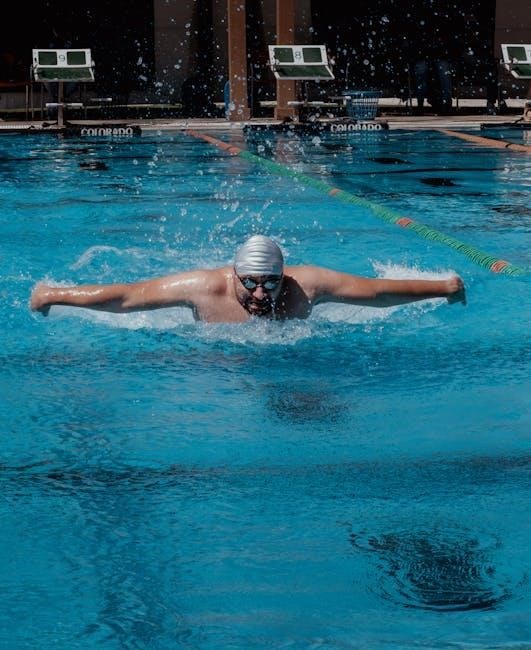
Components of a Swimming Pool Test Kit
A typical pool test kit includes reagents, test vials, comparators, droppers, and test strips for measuring pH, chlorine, alkalinity, and other essential water parameters.
Standard Tests Included in Pool Test Kits
Standard pool test kits typically include tests for pH, chlorine, alkalinity, and acid demand. These tests are essential for maintaining balanced water chemistry. The pH test measures water acidity, ensuring it’s safe for swimmers and equipment. The chlorine test checks sanitizer levels to prevent bacteria and algae growth. Alkalinity tests determine the water’s ability to resist pH changes, while acid demand tests help adjust alkalinity levels. Some kits also include tests for stabilizer (cyanuric acid) to protect chlorine from sunlight degradation. These tests provide a comprehensive understanding of pool water chemistry, enabling accurate adjustments for optimal water quality and safety. Regular testing ensures a clean, safe, and enjoyable swimming environment.
Reagents and Their Functions
Reagents are essential components of pool test kits, used to measure specific water chemistry parameters. Each reagent is designed for a particular test, such as pH, chlorine, alkalinity, or acid demand. When added to a water sample, these reagents react chemically, producing color changes or precipitates that indicate the concentration of the tested parameter. For example, chlorine reagents help determine sanitizer levels, while pH reagents measure water acidity. Proper use of reagents ensures accurate test results. Always follow the kit’s instructions for the correct order and amount of reagent to add. Reagents should be stored properly, away from heat and light, and replaced when expired to maintain reliability. Regularly checking reagent expiration dates is crucial for consistent and precise water testing outcomes.
Test Vials and Comparators
Test vials and comparators are crucial tools in pool test kits for accurate water chemistry analysis. Test vials are transparent containers used to hold water samples and reagents during testing. They are designed to ensure precise measurements and reactions. Comparators, on the other hand, are devices with built-in color standards that help users match the sample color to determine chemical levels. Proper use involves filling the vial to the marked level, adding reagents, and then inserting the vial into the comparator. Always clean and rinse vials after each test to prevent contamination. Comparators should be held at eye level in natural light for accurate color matching. Regular maintenance of these components ensures reliable test results and extends their lifespan.
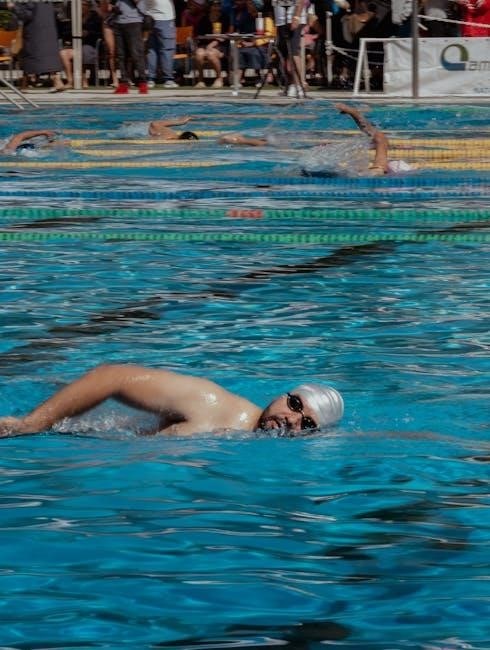
How to Choose the Right Pool Test Kit
Selecting the right pool test kit ensures accurate water chemistry analysis. Consider the types of tests needed, ease of use, and kit durability for reliable results season after season.
Types of Pool Test Kits
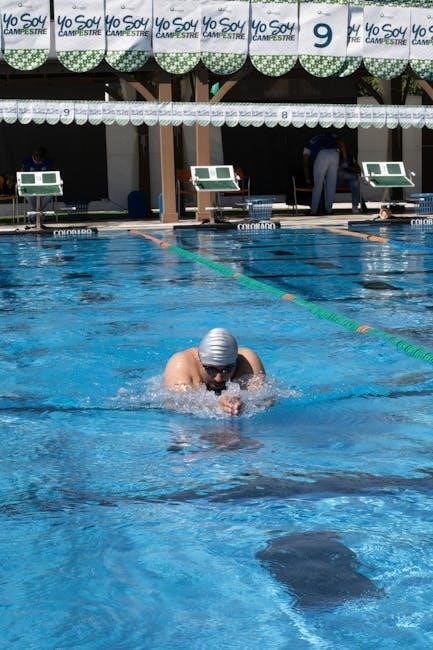
Pool test kits vary in functionality and design, catering to different user needs. Liquid test kits are highly accurate, using reagents for precise measurements of parameters like chlorine, pH, and alkalinity. Test strip kits offer quick, convenient results by comparing color changes on strips. All-in-one kits combine multiple tests in a single unit, simplifying the process. Some kits, like the Taylor K-1000, focus on essential parameters, while others, such as the K-2005, provide comprehensive analysis. The choice depends on the pool’s size, usage, and the user’s preference for simplicity or detailed data. Selecting the right type ensures efficient and accurate water chemistry management.
Features to Consider When Selecting a Test Kit
When choosing a pool test kit, consider its accuracy, ease of use, and the parameters it measures. Look for kits that test essential factors like chlorine, pH, alkalinity, and acid demand. Reagent quality and expiration dates are crucial for reliable results. Durable, well-organized cases and clear instructions enhance usability. Some kits, like the Taylor K-1000, are ideal for routine monitoring, while others, such as the K-2005, offer broader testing capabilities. Consider whether you prefer liquid reagents or test strips for convenience. Ensure the kit aligns with your pool’s size and usage. Additionally, check for features like color-coded bottles and comparators for easy interpretation; A good kit balances cost, functionality, and precision to maintain optimal water chemistry. Always follow the manufacturer’s guidelines for best performance.
Step-by-Step Guide to Using a Pool Test Kit
Learn to use a pool test kit with our step-by-step guide. Prepare your kit, collect a water sample, add reagents, titrate, and interpret results for balanced pool chemistry.
Preparing the Test Kit and Water Sample
Before testing, ensure your pool test kit is ready. Check reagent expiration dates and familiarize yourself with the kit’s components. Collect a water sample from 1-8 inches below the surface, away from return lines, to avoid contamination. Rinse the test vial thoroughly and fill it to the recommended level. Hold reagent bottles vertically for accurate drop dispensing. Store the kit in a cool, dry place to maintain reagent integrity. For reliable results, test water should be between 50-90°F. Proper preparation ensures accurate readings, helping you maintain optimal pool chemistry. Always follow the kit’s specific instructions for best outcomes.
Adding Reagents to the Water Sample
Adding reagents to the water sample is a critical step in pool testing. Always follow the kit’s instructions for the correct order and amount of reagents. Hold dropper bottles vertically to ensure consistent drop size. Gently swirl the sample after each drop to mix thoroughly. Some tests may require adding reagents sequentially or using a specific method, such as titration. Avoid touching the dropper tip to the vial to prevent contamination; For accurate results, count drops carefully and wait for the specified color change. Proper reagent addition ensures reliable test outcomes, helping you maintain balanced pool chemistry. Adhere to the kit’s guidelines for precise measurements and consistent results.
Titration Process and Counting Drops
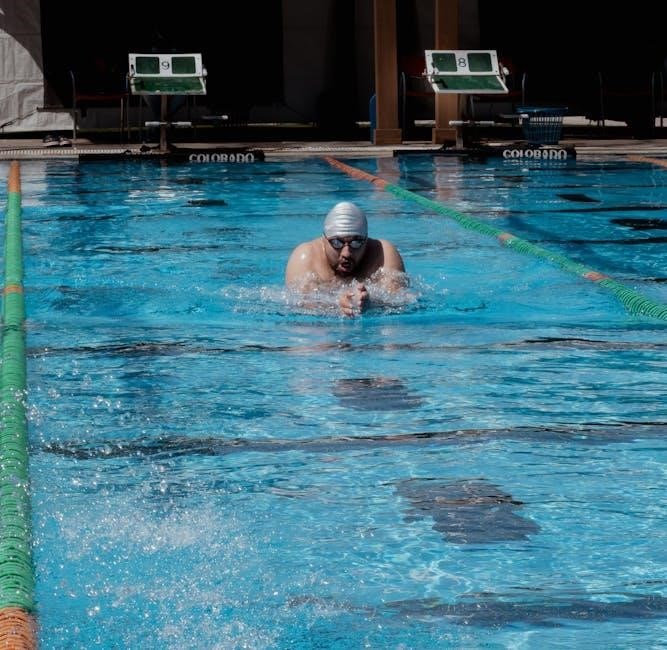
The titration process involves adding reagent drops to the water sample until a color change occurs. Start by filling the test vial with the sample and adding the first reagent. Swirl gently after each drop. Continue adding drops one at a time, counting carefully, until the solution reaches the target color. The total number of drops used determines the test result. For accuracy, hold the dropper vertically and avoid touching the tip to the vial. Some tests may require multiple reagents or sequential addition. Always follow the kit’s instructions for the correct titration method. Proper counting and swirling ensure precise measurements, helping you maintain optimal pool chemistry. Regular practice improves your technique and test reliability.
Using Test Strips for Quick Results
Test strips provide a fast and convenient way to measure pool water chemistry. Simply dip the strip into the water, ensuring all pads are submerged, then remove it immediately. Shake off excess water and compare the color changes on the pads to the chart provided. Each pad corresponds to a specific parameter, such as pH, chlorine, or alkalinity. Results are visible within seconds, making test strips ideal for routine checks. They are pre-measured and eliminate the need for titration, offering a hassle-free alternative. While less precise than liquid kits, test strips are reliable for quick assessments and maintaining balanced water conditions. Regular use helps ensure a safe and enjoyable swimming environment.
Interpreting Test Results
Interpreting test results is crucial for maintaining optimal pool water chemistry. After conducting tests, compare the color of the water sample to the standards provided on the comparator or test strip chart. Match the sample color to the closest reference to determine the chemical levels. For titration tests, the number of drops required to achieve the color change indicates the concentration of the tested parameter. Accurate interpretation ensures proper adjustments to pH, chlorine, alkalinity, and other levels. Always refer to the kit’s instructions for specific guidance. Consistent and precise interpretation helps prevent imbalances that could harm equipment or swimmers. Regular testing and accurate result interpretation are key to a safe and enjoyable pool experience.
Best Practices for Accurate Test Results
Follow kit instructions precisely, sample water consistently, and avoid contamination. Test at the same time daily, store reagents properly, and replace them as needed for reliable outcomes.
Proper Water Sampling Techniques
Collecting a water sample correctly is crucial for accurate test results. Submerge the collection tube or comparator elbow-deep in the pool, away from return lines, to avoid skewed readings. Ensure the water temperature is between 50°F and 90°F for reliable testing. Always use a clean, dry container to prevent contamination. For consistency, test at the same time daily, preferably in the morning before sunlight or swimmer activity affects the water. Avoid sampling after chemical additions or during rain, as these can alter results. Proper water sampling ensures your tests reflect the pool’s true condition, helping you maintain safe and balanced water chemistry throughout the season.
Maintaining Test Kit Condition
Properly maintaining your pool test kit ensures accurate and reliable results. Store the kit in a cool, dry place, away from direct sunlight and heat sources. After each use, tighten reagent bottles securely to prevent contamination and evaporation. Replace reagents at the start of each swim season or sooner if you notice color or texture changes. Regularly clean and rinse test vials and comparators to avoid residue buildup. Avoid cross-contaminating reagents by not touching dropper tips to surfaces. By keeping your test kit in good condition, you ensure precise water chemistry measurements and extend the kit’s lifespan. Consistent maintenance is key to achieving accurate test results and maintaining optimal pool water quality.
Regular Testing Schedule
A consistent testing schedule is essential for maintaining optimal pool water quality. Test your pool water at least once daily, preferably in the morning before swimmers enter. This ensures accurate readings unaffected by daytime factors like sunlight or bather load. After chemical adjustments, wait 24 hours before retesting to allow the treatments to distribute evenly. For high-usage pools or those exposed to heavy rain or sunlight, consider testing twice a day. Regular testing helps detect subtle changes in water chemistry, enabling prompt adjustments to maintain safety and clarity. By sticking to a routine, you can prevent imbalances and keep your pool water clean, safe, and enjoyable for swimmers throughout the season.
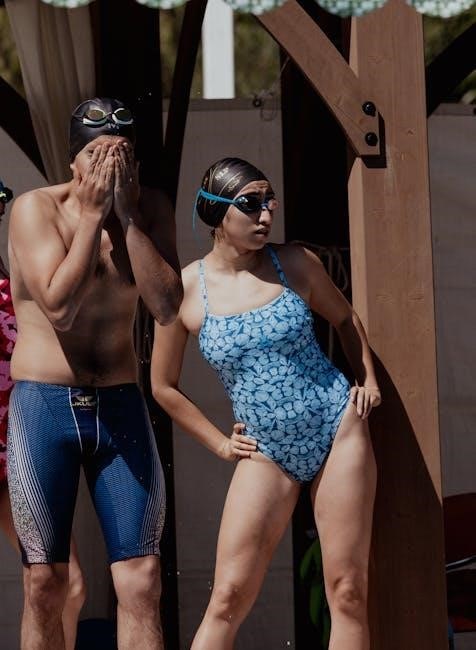
Troubleshooting Common Issues
Common issues include inaccurate results and reagent contamination. Always follow instructions, avoid cross-contamination, and test patiently to ensure reliable outcomes for your pool water chemistry.
Dealing with Inaccurate Test Results
Inaccurate test results can occur due to improper sampling, contamination, or not following instructions. Ensure water samples are taken from elbow depth, away from return lines, and at the correct temperature (50–90°F). Avoid touching dropper tips to the comparator to prevent cross-contamination. Always hold droppers vertically and swirl gently after adding reagents. If results are inconsistent, retest using a fresh sample. Skipping steps or rushing the process can also lead to errors. Replace expired reagents and store them in a cool, dry place. For reliable outcomes, test at the same time daily, ideally in the morning, before environmental factors affect the water. Regularly cleaning and maintaining your test kit ensures accurate readings.
Avoiding Contamination of Reagents
Avoiding contamination of reagents is crucial for accurate test results. Always hold dropper bottles vertically to ensure proper drop size and prevent cross-contamination. Never let reagents remain in the test vial, as this can alter future tests. After each use, clean and rinse the vial thoroughly. Store reagents in a cool, dry place, away from direct sunlight and heat. Tighten bottle caps securely after use to prevent exposure to air. Replace reagents if you notice any color or texture changes, as they may have degraded. Regularly inspect your test kit for wear and tear, and replace any damaged components. By maintaining your reagents and following proper handling techniques, you ensure reliable and consistent test outcomes for optimal pool water quality.
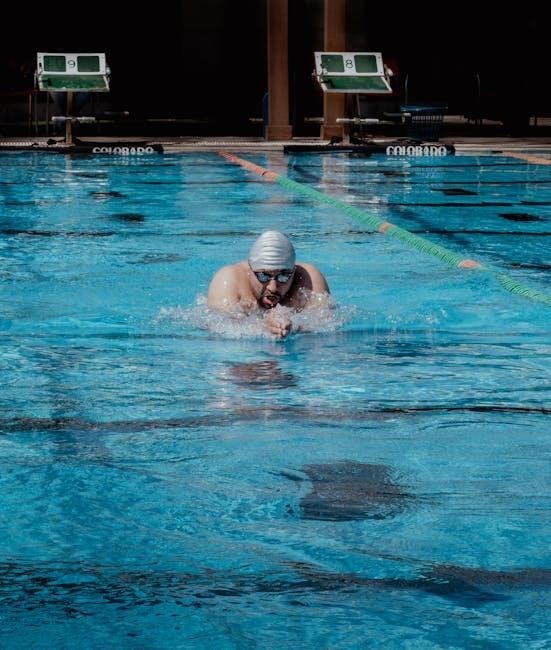
Maintaining Your Pool Test Kit
Properly store reagents in a cool, dry place, away from direct sunlight. Replace expired reagents and clean the kit regularly to ensure accuracy and longevity.
Storing Reagents Properly
Proper storage of reagents is crucial for maintaining their effectiveness and ensuring accurate test results. Store reagents in a cool, dry place, away from direct sunlight and heat sources. Avoid exposing them to extreme temperatures, as this can degrade their chemical properties. Always tighten reagent bottles securely after use to prevent contamination and evaporation. Keep the test kit away from children and pets to avoid accidental tampering. Reagents should be replaced at the start of each swim season or sooner if you notice any changes in color, texture, or odor. Proper storage ensures your pool test kit remains reliable and provides accurate readings for optimal water quality maintenance.
Replacing Expired Reagents
Replacing expired reagents is essential for maintaining the accuracy of your pool test kit. Check the expiration dates on reagent bottles regularly, as outdated chemicals can lead to unreliable results. Replace reagents at the beginning of each swimming season or sooner if you notice any visible changes, such as discoloration or sedimentation. Always purchase reagents from trusted manufacturers to ensure compatibility with your test kit. Properly dispose of expired reagents according to local regulations. By keeping your reagents up to date, you ensure precise water chemistry measurements, which are critical for maintaining a safe and balanced pool environment. Regular replacement is a simple yet vital step in preserving the effectiveness of your pool test kit.

Understanding Pool Water Chemistry
Pool water chemistry involves testing key parameters like pH, chlorine, alkalinity, and acid demand to ensure a safe and balanced swimming environment. Regular testing prevents imbalances that can cause cloudiness, eye irritation, or equipment damage, ensuring optimal water quality for swimmers;
Key Parameters to Test
When using a swimming pool test kit, it’s essential to monitor key parameters to ensure water safety and clarity. These include pH levels, which should range between 7.2 and 7.8 for swimmer comfort and sanitizer effectiveness. Chlorine levels must be checked to ensure proper sanitation, typically between 1 and 3 ppm. Total alkalinity should be maintained between 80 and 120 ppm to stabilize pH levels. Acid demand testing helps determine the amount of acid needed to adjust alkalinity. Additionally, calcium hardness should be tested to prevent corrosion or scaling, and stabilizer (CYA) levels should be monitored to protect chlorine from sunlight degradation. Regular testing of these parameters ensures balanced and safe pool water conditions for swimmers.
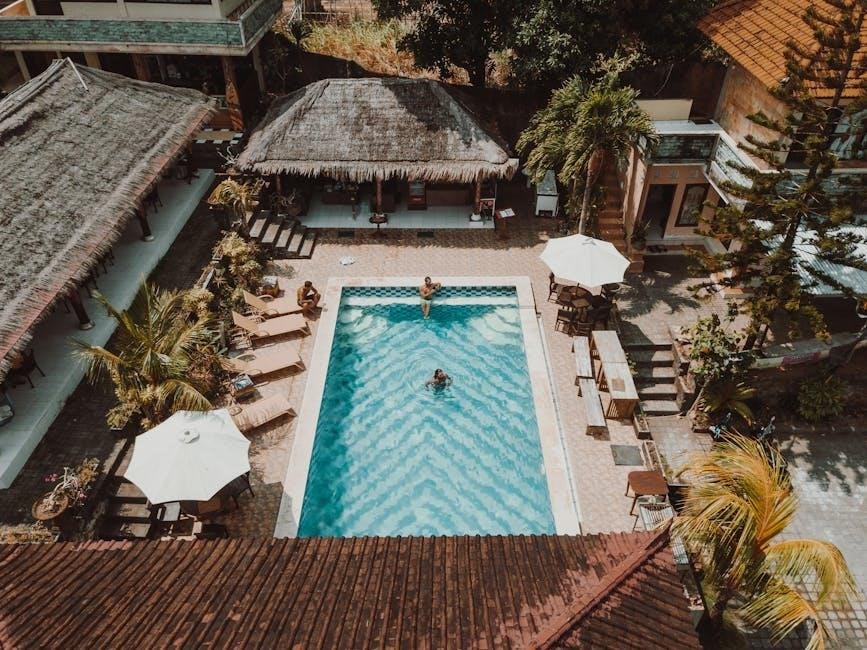
Interpreting and Adjusting Chemical Levels
Interpreting pool test results is crucial for maintaining optimal water chemistry. Compare your test results to the recommended ranges: pH (7.2–7.8), chlorine (1–3 ppm), and alkalinity (80–120 ppm). If levels are off, adjust accordingly. For low pH, add a pH increaser; for high pH, use a decreaser. Adjust chlorine by adding sanitizer or shocking the pool if levels are too high. For alkalinity, add an alkalinity increaser if low or acid if high. Always follow the manufacturer’s instructions for precise adjustments. Regular testing and adjustments ensure a safe, balanced, and enjoyable swimming environment. Proper chemical levels prevent eye irritation, equipment damage, and algae growth, making routine testing essential for pool maintenance.
Using a swimming pool test kit is essential for maintaining clean, safe, and balanced water conditions. By following the instructions and best practices outlined in this guide, you can ensure accurate test results and make necessary adjustments to keep your pool water optimal. Regular testing helps prevent chemical imbalances, protects equipment, and ensures a safe environment for swimmers. Remember to always follow the manufacturer’s guidelines and maintain your test kit properly. With consistent use and proper adjustments, you can enjoy a healthy and enjoyable swimming experience all season long. Take control of your pool’s water chemistry today and make informed decisions for a pristine pool.
